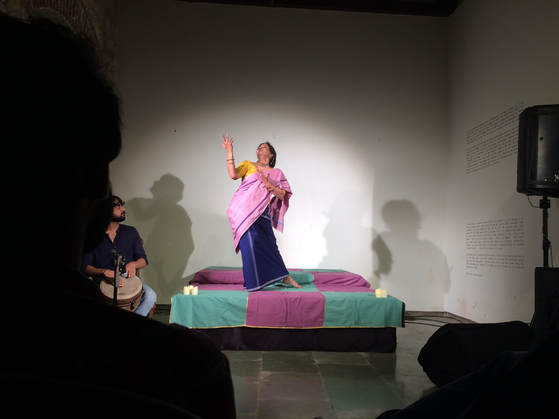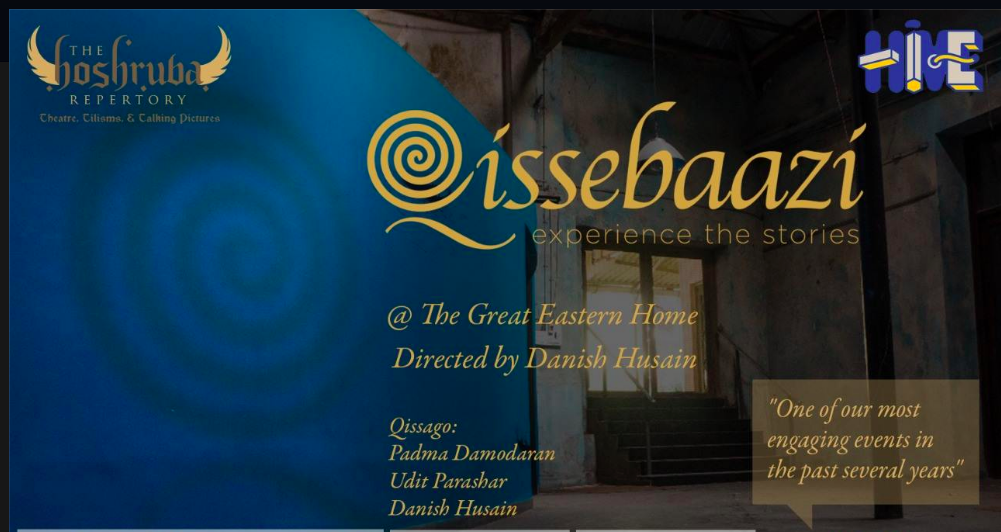|
After a low-key Onam sadya*, I'd a beautiful evening listening to storytelling, i.e. Qissebaazi in Urdu language. Theatre events in Mumbai used to be known for its punctuality. This is changing rapidly. Today's show got delayed nicely by 20 mins - when it comes to timing I am more Dutch than a Dutch citizen and I arrive 20 mins before time! Anyways, during this 40 mins waiting time I'd a chance to continue playing on phone 'Godot Godot' - with 8 year son of my friend. He acts Pozzo and I'm his Lucky .. This is my second blog on Qissebaazi already in three months! In May, while dealing with Mumbai summer wave, I'd watched for the first time Qissebaazi and I spontaneously became a fan. Since then I have been following this unique storytelling show in Mumbai, which is directed by Danish Husain under his production company, the Hoshruba Repertory. A few days ago, my nephew suggested a couple of indie Hindi films (a fact that I watched more Iranian & Latino films than Bollywood Hindi films) and one of the suggested films I happen to watch on Netflix was Ankhon Dekhi.. a nice surprise to see Husain in this film and to learn he is also a film actor. The two performances lined up for today's event at Hive, the Great Eastern Company, Byculla, Mumbai were in Malayalam and Urdu languages. The uniqueness in appreciating this art form of storytelling lies in the idea to bridge the culture gap breaking language barriers. To me Qissebaazi is one of the most creative form of art using storytelling in a culturally diverse country like India, particularly, more so in this current political scenario. All my indie documentaries under the Landing Together films are multilingual primarily to have a culture of language inclusivity - showcasing diverse ethnic tribal and indigenous peoples' languages bridge nature conservation. For example, when I use different tribal/adivasi languages in my film to narrate a social issue, it brings a deep cultural meaning with power wherein language is not just to share the information/ story, but to show how it shapes protagonist's opinions, perceptions, customs, and builds (or breaks) collective identities. Probably that's another reason why I am better able to connect with Qissebaazi's unique format. Danish Husain's justification to tell stories in different languages works well because of the way he understands his audience and uses creativity in executing the stories. He does so by dividing each story into two languages. A 'core' language is that of the text, and a symbolic 'bridge' language often either in Hindi or English that helps the audience to comprehend the story. By bringing stories in original language(s) in front of an urban-literate audience raises a crucial question about their 'languaculture adaptability' i.e. how do audience from culturally diverse background understand a story in a foreign language that belongs to another culture. Padma Damodaran, opened her story with a Malayalam poem - a tribute to Kerala's fishermen who extended their unconditional support in disaster rescue operations during the recent floods. She picked up a beautiful story, 'Wooden Dolls', written by Karoor Neelakantha Pillai - of course, none from the audience (including me, I was born after his death) knew this famous short story writer. I'm not elaborating the plot here. Padma kept her audience engaged till the end - using Malyalam as core and English as the bridge language. I liked the structure of today's programme wherein Danish did the introduction, followed by Padma's dance-song-story, and finally Danish wrapping up with a nice dastangoi/storytelling from Dastan-e-Amir-Hamza in bilingual - Urdu and Hindi. You might want to attend one of this storytelling events. On my way back home - two hours train journey - looking at August's beautiful Sturgeon full moon made me ponder on how nature and art has been separated in Mumbai's urban setting. I wish we can have some daredevil artists taking their art events to beaches, forts and mountain camps and pushing the urbanites out of their pigeon holes to enjoy theatre, storytelling, dance in relatively natural settings.... But, I doubt whether mainstream audience is ready to leave their popcorn comfort zone of watching commercial Bollywood films. At least I am exploring option to screen my films in open sky theatre.. or forests. Till then time to prepare for my short film screenings, including one in India at Vikalp@Prithvi, Prithvi theatre, Mumbai on Friday, 26/10. *Onam is a harvest festival originated and celebrated in the southern state of Kerala. Onam sadya is a typical traditional homemade food to celebrate this festival. @purabibose.com
0 Comments
There is no greater agony than bearing an untold story inside you ~ said Maya Angelou. The art of storytelling is what kept human civilisation's love for culture intact. Stories are like a river it keeps flowing even if it has a barrier it flows by changing the route, but never stops. As someone once told me, ...[If] you want to understand a culture then listen to their stories. The month of May I'm rarely around in Mumbai, but this year am ready to experience the heat and humidity. Mango allergy (thanks to calcium cyanide chemical used for ripening this commercial fruit) kicked me nicely already this summer. Mangoes and summer month refreshed my childhood memories. During the afternoons - before the days of air conditions and mobile phones - the summer school holidays for us was hanging under the mango, lemon and jackfruit trees with punjabi, marathi, sindhi and bengali friends playing 'story-story' and practicing 'abriti' (a Bengali word for reciting poems). Few days ago, I received a notification about upcoming event Qissebaazi, and I couldn't resist to click @BookMyShow. About 65km distance i.e. two hours by central local train - that's only one-way journey to listen to a story-telling all the way to Mumbai's Byculla area is something people in my neighbourhood would find hilarious. This is just to explain you the culture of thy neighbourhood matters... Interestingly, The Hive @the Great Eastern Home is nicely tucked 5 minutes around the corner of famous Byculla Zoo. The only lovely memories of the zoo are of the two Baobabs, rest of the zoo's fauna hope finds freedom from chains :-) My first time to the Hive (haven't been to their Bandra location, yet) and am totally impressed with the decor and ambience. The seats @the Hive for the performance was all full by the time I arrived and was lucky to find one seat on the front row - an advantage of travelling single ;-) What to expect when you know nothing about the actors, directors or the stories - I dislike the idea of googling reviews before the plays. The smooth drum beats and soft green lights on the 'stage' background helped audience to calm down - and I was ready to listen. The first story was by the Danish Husain, the director himself. The interesting part of this storytelling was using multi-lingual - Urdu, Malayalam and Hindustani/ Hindi. I was told that the trick of listening to storytelling is to maintain the eye contact with the protagonist, which I realised immediately. The audience of about fifty people kept uttering Wah Wah .. just was an indicator how actors managed to engage the audience. An approach of Dastangoi - the art of storytelling - is about engaging the audience rather than keeping them as mere spectators, which dastango Danish Husain nicely executed in the first 30 mins. The storytelling itself was one tiny bit from dastan e-Amir Hamza's stories. The voice, body language and eye movements and captivating punchlines were completing the words of the story. Just as much exciting it is to know there are thousands of stories to be told from Amir Hamza's work I hope to return to watch Husain's work again. I'm impressed. The next half an hour was another story telling by Padma Damodaran. Damodaran began her performance - a dance and singing in Malayalam. She stops and engages with the audience to translate the meaning of title - a tale of rabbit - and asks audience to repeat the words in Malayalam (Muyol = rabbit).. and she jokes away smartly hinting to the long debate of North and South India's language culture. What amused me is she was using her entire body, unlike a static storyteller - she was dancing and acting while telling a beautiful story. Though it may appear as a children's story, but you know its so much of those untold stories within the story you are listening leaving it entirely on the audience to interpret - gun control, animal cruelty, love, parent-child relationship.. damn, I am just imagining! The final half an hour was equally enthralling by Udit Parashar. I am not going to tell his story but let me tell you that never before this show I thought that there can be a story all about 'spitting'. Udit's voice modulation, expression and his style of using minimum movement, yet strategic one kept audience capsized (at least me!). His storytelling ended without any ends, and though the audience gave a loud sound of clapping the murmurs was like, "I want to know how it (the story) ends.... can't we continue!" Overall, Qissebaazi acts like a teaser to pull you towards the addiction of listening to stories - and it works! Knowing that after the show I will reach home around mid-night, I'd packed some fresh baked goodies including ginger nankhatai from the famous American Express Bakery (Byculla West).
It was a good idea to munch while travelling back in the Karjat fast local train.. although I knew that the hunger to hear more stories just got worsen after this amazing Qissebaazi performance. More stories to be continued.... P.S. The crowd was South Mumbaikaris, but the ticket cost at INR 300 was a plus for many to enjoy the show. I haven't seen the above youtube link of Qissebaazi performance, but you might want to check it. There is nothing like a live show. |
Privacy Policy: We use Google Analytics to collect data to improve the Website. By using and accessing the website you are consenting to use of Google Analytics. All Rights Reserved.
ARchIvES
March 2019
CATEGORIES
All
Privacy Policy: This website uses Google Analytics to improve the Website. By using and accessing the website you are consenting to use of Google Analytics.
|





 RSS Feed
RSS Feed
